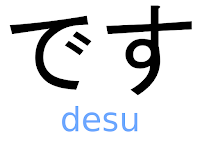 There are a lot of differences in how the Japanese language is used compared to English. One of these differences is in the verb "to be". Lets take a look at how to use "to be", some confusions about using it, and some example sentences.
There are a lot of differences in how the Japanese language is used compared to English. One of these differences is in the verb "to be". Lets take a look at how to use "to be", some confusions about using it, and some example sentences.First, there are 3 different ways to say "to be" in Japanese:
Since you already learned about です in a previous lesson, let's look at いる and ある, and when each of them are used.
いる is used to refer to anything that is living. This does not include things that would be considered philosophically alive. いる can also be used to say that something is at a location. An example would be a dog (犬).
ある is used to refer to anything that is not living. This includes things that used to be alive, but are no longer. ある can also be used to say you have something that is not living. An example would be a rock (石).
Here are some sentences to try translating into Japanese. Would you use です, いる or ある?
A cat is here.
Is that a tree?
I have a pencil.
Mr. Yamada is over there.
Is Hibiki here?



No comments:
Post a Comment